Reading Comprehension Text and Exercises
Israel
The Holy Land
For many thousands of years, people from different ancient civilizations, cultures and nations have come to Israel, a small country in the Middle East. Known as "the Promised Land" for the Jewish people, Israel is also home to people of other religions and a great number of buildings and sights important to them.
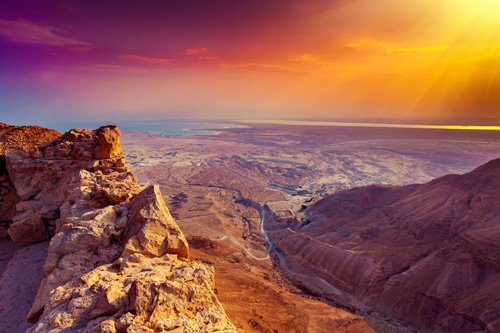
Click Here for Step-by-Step Rules, Stories and Exercises to Practice All English Tenses
A Brief History of Israel
- Standing as a gateway from Asia to Africa and Europe, Israel had been conquered by multiple old empires before the 20th century. In brief, it started as the Judean Kingdom of King Saul, the first king, around 1000 BC. It is believed that before that, a prophet called Moses, who taught the words of God, led the people expelled from Egypt to the Israeli land, which was promised by God.
- Afterwards, the land was conquered by, among others, Alexander the Great, the greatest ancient Greek leader. The independent Jewish state was reestablished and lasted until the land was occupied by the Romans in 63 BC.
- In 70 AD, Jews revolted against the Romans, which is why they were expelled from the land. They had to move to different countries in Europe, North Africa, and Asia.
- Muslim forces, and later the Ottoman Empire (present-day Turkey) ruled Jerusalem for six centuries. The Dome of the Rock, a landmark mosque, was established during that period, and the walls of the Old City were rebuilt.
- The current state of Israel was established in 1948. It is a small country, covering roughly 8,000 square miles and home to some 8.65 million people. It has an abundance of ethnic diversities, as well as different landscapes and sceneries. Jerusalem remains a holy site for Jews, Christians and Muslims.
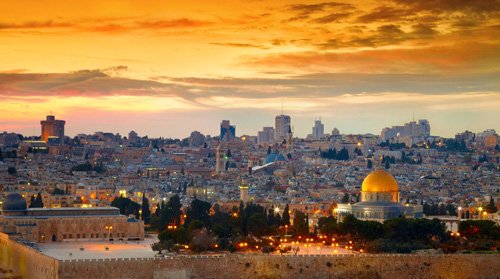
Old Jaffa
Jaffa is the oldest part of the modern city of Tel Aviv. An ancient myth suggests that this old port city got its name after Yafet, one of the sons of Noah, who saved animals and humans from a large flood.
The place has been used as a strategically important harbor for thousands of years. Walking around the Old Jaffa today, you will see all these different layers of history.
The Clock Square stands in the middle of Jaffa, with its distinctive clock tower built in 1906. Another interesting sight is the Andromeda rock, the rock where, according to mythology, Greek goddess Andromeda was chained as a sacrifice before she was saved. Nearby, there is the Al-Bahr Mosque, or the Sea Mosque, a small tower overlooking the harbor, historically used by fishermen and sailors.
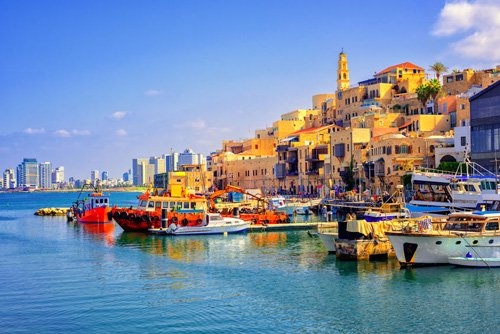
Mount of Olives, Jerusalem
Just outside Jerusalem's Old City lies the Mount of Olives, named after the olive groves that used to cover its slopes. The mountain is filled with sites that are important for several religious groups.
It has hosted a Jewish cemetery for at least 3,000 years. A couple of ancient monumental tombs can be found in the Kidron Valley which lies beneath the mount. Christians believe that this is also where Jesus Christ, the son of God, ascended to heaven, which is why it is a major site of pilgrimage.
The largest church that rises on the mountain is the Church of Mary Magdalene, built by a Russian Tsar (ruler) in 1886, noticeable for its gilded roofs.
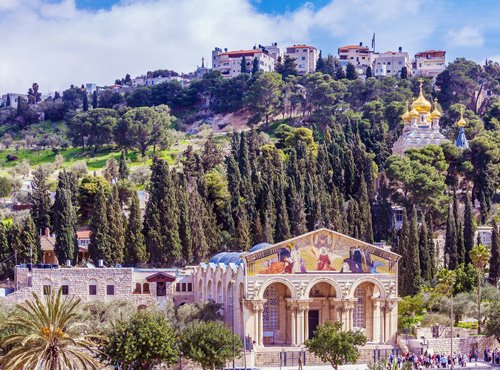
Sea of Galilee
Also known as Kinneret, the Sea of Galilee is the largest freshwater lake in Israel. The lake is actually located some 200 meters below sea level, which makes it the lowest freshwater lake in the world.
The Sea of Galilee was historically very important because it was on the Via Maris, an ancient route which connected Egypt with the empires in the North.
Nowadays, tourists are drawn to this lake for two major reasons. Firstly, Jesus is believed to have taught and performed many of his miracles in the areas around the lake, so Christians frequently visit there.
Secondly, Israelis and tourists come to the lake to take part in different water activities, such as the building of rafts event, or the Kinneret Crossing, a popular open water swim race.
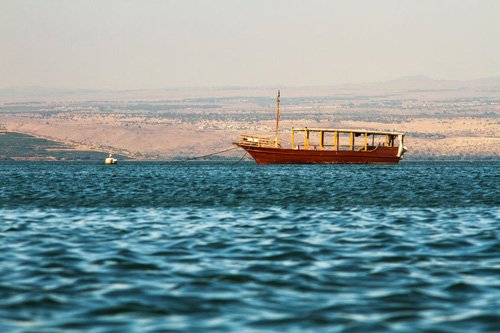
Rosh HaNikra Sea Caves
In Hebrew, rosh means "head" and hanikra means "of the caves", which explains what this amazing rock formation is all about. White cliffs open into amazing caves in this area located on the coast of the Mediterranean Sea.
Being close to the Israeli border with Lebanon, for centuries Rosh HaNikra was a passage point for traders and armies. While they were building a railroad, the British dug a tunnel thanks to which, all sea caves are now connected to each other.
Years ago, only adventurous swimmers could see this place, but today, visitors can get on the Rosh HaNikra cable car, the steepest one in the world, to take them to the caves.
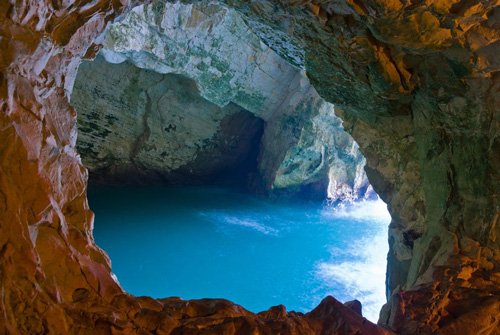
Mini Israel Park
For all those who cannot find enough time to visit all tourist attractions in Israel, a possible solution could be to go to Mini Israel, a miniature park where hundreds of replicas of famous sights in Israel are located.
Nearly all buildings are built to be 25 times smaller than they are in real life. This means that an average church would be as tall as a child, while a skyscraper might be a little bit taller than an adult.
There is a true variety of miniatures – from important religious and historical buildings, to archaeological sites and some modern structures such as the Supreme Court of Israel.
Figures of people, animals, plants and vehicles are also added to make the miniatures resemble to the originals even more.
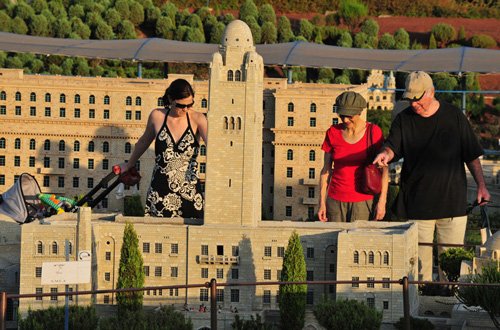
See Israel, the Holy Land, Part 2
Comprehension Exercises
Vocabulary Questions
- What does "landmark" mean?
- borders of a city
- land used for agriculture
- easily recognized building, even from afar
- What does "replica" mean?
- exact copy of something
- replacement for something
- distant cousin
- What does "revolt" mean?
- returning to the promised land
- repairing an old building
- taking a violent action against the ruler
- What does "beneath" mean?
- on the top
- under, at a lower level
- above, at a higher level
- What does "miracle" mean?
- dining ritual
- secret teachings during the Roman era
- extraordinary event performed by a god
Collocation Questions
- Via Maris was an ancient route which __________ Egypt with northern empires.
- linked
- associated
- connected
- In 70 AD, the Jewish people were __________ from Jerusalem.
- removed
- expelled
- evicted
- The state of Israel was established __________ 1948.
- at
- on
- in
- Israel has been a __________ from Asia to Africa.
- gateway
- doorway
- stairway
- Rosh HaNikra was a __________ point for traders.
- transit
- passage
- traveling
- The British __________ a tunnel around the caves.
- dug
- hollowed
- worked
- It is believed that Jesus __________ to heaven.
- ascended
- mounted
- arose
- Independent Jewish state was __________ after Alexander the Great.
- reinitiated
- reinstalled
- reestablished
- Kinneret Crossing is __________ water swim race.
- a wide
- an unbarred
- an open
- The Dome of the Rock is a __________ mosque.
- signal
- landmark
- recognizable
Wh Questions
- Why do pilgrims visit the Sea of Galilee?
- because Jesus ascended to heaven there
- because some of Jesus' miracles happened there
- because Jesus was born there
- Who originally used the Sea Mosque?
- sailors
- Ottoman sultans
- Greek gods
- What does Rosh HaNikra mean?
- the head of a sea horse
- the head of the caves
- the face of gods
- How small are the miniatures in the Mini Israel Park?
- only 3 times smaller than real ones
- smaller than babies
- usually 25 times smaller than real ones
- When was the modern state of Israel established?
- in 1948
- in 1900 BC
- in 70 AD
Evaluating Statements
- Based on the information in this lesson, which statement is true?
- Noah had a son called Yafet.
- Noah had three daughters and no sons.
- Based on the information in this lesson, which statement is false?
- Rosh HaNikra is accessible by car.
- Rosh HaNikra is accessible by cable car.
True or False?
- Based on the information in this lesson, is the following statement true or false?
"Mount of Olives is located in the Old City of Jerusalem." - True
- False
- Based on the information in this lesson, is the following statement true or false?
"The ancient Via Maris route went through Israel." - True
- False
Answer Key
1. C | 2. A | 3. C | 4. B | 5. C | 6. C | 7. B | 8. C | 9. A | 10. B | 11. A | 12. A | 13. C | 14. C | 15. B | 16. B | 17. A | 18. B | 19. C | 20. A |21. A | 22. A | 23. B | 24. A
Get Updates, Special Offers, and English Resources
Download your FREE GIFT (the first two chapters of
English Short Stories Book and Workbook)
as soon as you join!

By submitting your email, you consent to receiving updates and newsletters from us and to the sharing of your personal data with third parties for the purposes of sending you communications. We will not spam you. You can unsubscribe at any time. For more information, please see our privacy policy.





